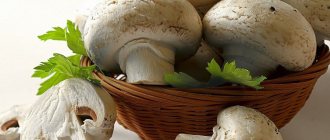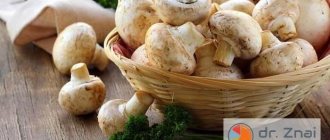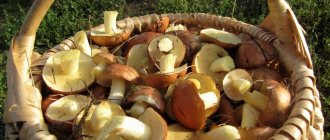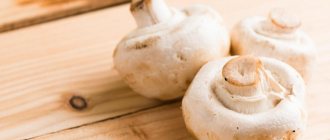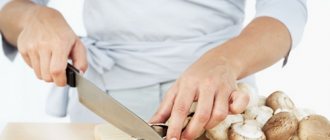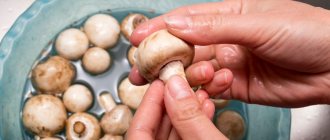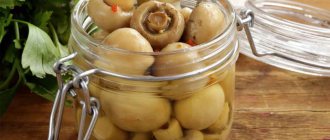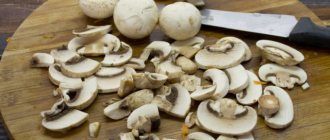Champignons are very tasty mushrooms. Not only lovers of delicious food are sure of this, but also real gourmets, true connoisseurs of haute cuisine.
These mushrooms have a pleasant taste and aroma. In addition, champignons contain many useful substances. Champignons can be fried and baked, used for preparing appetizers, salads, first and second courses. However, in addition to cooking, it is important to know how to choose and store mushrooms correctly. You will find information on how to select and preserve champignons at home here.
Choosing champignons
The shelf life of champignons directly depends on the choice when purchasing. Good mushrooms should be light-colored (white or slightly brownish) and clean, without visible damage or stains. It is advisable to purchase mushrooms of the same size. Fresh mushrooms feel firm, elastic and slightly porous to the touch. They should have a light and pleasant mushroom aroma. Avoid buying darkened and slippery mushrooms. This state of the mushrooms indicates the presence of toxins in them, which is very dangerous to health.
Shelf life of champignons
Now fresh champignons are sold in almost any grocery store, but many people prefer to have a small strategic supply of champignons “just in case.” These people are then puzzled by the question: how long can champignons last? Of course, it is better to store them in suitable conditions. The shelf life of mushrooms depends on the form in which and where they will be stored. For example, mushrooms can be stored at room temperature for no more than 2-3 hours. In the refrigerator, the shelf life of champignons increases significantly and ranges from 3 days to a week. And of course, champignons last longer in the freezer.
Labeling on packaging
You can find out the expiration date of champignons on the packaging. Labeling of consumer packaging of champignons is carried out in accordance with GOST R 51074. The following must be present on the container:
- date of collection and packaging;
- food storage conditions.
Information is applied to consumer packaging or labels using water-resistant, non-toxic paint or ink. It is prohibited to make changes to the factory markings. When choosing products, you should pay attention to the integrity of the packaging and the completeness of the required information.
How to prepare for storage
Often, mushrooms are prepared for future use during the peak of their harvest, or purchased in advance before major holidays. Now mushrooms are almost always on sale, but information about storage will be relevant in any season.
If you want to know how to keep mushrooms fresh until the New Year, below is all the information you need.
The shelf life of mushrooms directly depends on their preliminary preparation. Before you put collected or purchased mushrooms in the refrigerator or freezer, they need to be prepared for storage.
Preparation consists of several stages:
- sorting champignons (only whole and light mushrooms are selected for storage. Champignons with spots and damage are best used immediately for cooking. Eating spoiled mushrooms is strictly prohibited);
- cleaning (you need to wipe off dirt from the surface of the mushrooms with a dry cloth);
- drying (it is better to dry the mushrooms if they are wet);
- preparing the container (it must be clean and dry).
It is not recommended to wash mushrooms before storing them in the refrigerator. They, like a sponge, absorb excess liquid, which not only reduces their shelf life, but also worsens their taste. In addition, unwashed mushrooms can remain on a shelf in the refrigerator for up to 10 days.
Preparatory procedures
The champignons are stored immediately. This rule applies to mushrooms purchased and personally collected. The product must first be prepared:
- clean each copy from particles of debris;
- trim the legs by 0.5 cm;
- carefully remove dirt from the caps;
- Remove all damaged parts.
Champignons soiled with soil and intended for storage are not washed. This way they stay fresh longer. Wipe the mushrooms with a clean, soft and dry cloth. Specimens soaked in water quickly begin to darken and deteriorate.
Champignon caps have the ability to quickly absorb moisture. This leads to an acceleration of the decay process.
Cold storage
According to sanpin, champignons must be stored for 4-5 days at a temperature from 0C to 2C or 2-3 days at a temperature of 5C from the moment of collection. Mushrooms can be stored in the basement if it is clean and cool.
Storing fresh champignons in the basement is not much different from storing them in the refrigerator, because usually the conditions there are almost the same (dark and cool). But more often, champignons are stored in the refrigerator so that they do not spoil. There is an optimal temperature and humidity for them. There are three storage methods you can use:
- Storage in a plastic food container. It is important that the container lid is not tightly closed. They can be either whole or sliced.
- In a cotton bag. This is an excellent storage space with natural ventilation. This way, condensation will not form on the mushrooms, and they will be stored longer.
- In a paper bag. Storing champignons in the refrigerator in a paper bag is also a good way to extend the shelf life of the product.
In addition to the methods listed above, champignons can also be stored in polyethylene in the refrigerator. However, you will have to ventilate them periodically due to the risk of condensation and rapid spoilage of the product. When stored in a paper bag or cotton bag, mushrooms remain fresh and edible for 7 days.
If you notice that the mushrooms have darkened a little, it is better to cook them immediately, otherwise they will simply spoil in a couple of days. In this form, champignons are stored very poorly in the refrigerator. If they have already turned black, it means they have spoiled, feel free to throw them away. Information on how to store fresh, boiled or fried champignons is below.
Raw
Few people know how to store fresh champignons in the refrigerator. It is better to clean fresh specimens dryly to remove contaminants, place the already peeled mushrooms in a plastic container or paper bag, and then put them in the refrigerator.
There is also this method: before storage, mushrooms are cleaned without rinsing with water and placed in one layer in a compartment for storing vegetables and fruits. Place a cotton towel on top. The disadvantage of storing fresh champignons this way is that it is impossible to fit a lot of mushrooms in one layer, and it is not recommended to lay them in several layers. In plastic or glass containers, as well as in a paper or cellophane bag, mushrooms can be stored for up to 3 days on the middle shelf of the refrigerator at a temperature of 0 to +2 C. Longer shelf life of champignons in the refrigerator leads to loss of moisture from the product, which significantly affects their appearance (they darken) and taste.
In order for store-bought mushrooms to retain their flavor for longer, it is better to store them in a slightly open container or bag, and, if possible, cook them as soon as possible.
Boiled
Heat treatment slightly shortens the shelf life of champignons. Experts recommend storing boiled champignons for a day or two, no more. Eating boiled champignons after this period is undesirable; it is dangerous to health.
Fried
Many housewives are interested in the question: how long can fried champignons be stored in the refrigerator?
People are puzzled by this question when they have cooked too much at one time, or simply haven’t eaten mushrooms due to the abundance of other dishes on the table. Fried mushrooms, like boiled ones, are also best not to be stored in the refrigerator for a long time. To prepare fried mushrooms, unlike boiled ones, vegetable oil and higher temperatures are used, but the finished product cannot be stored in the refrigerator for a long time. The shelf life of mushrooms in cooked form is shorter than in raw form.
Harm and benefit
Champignon belongs to the Agaricaceae or Champignonaceae family. In addition to the product described, this family includes more than 10 different types of mushrooms. The most common are raincoats and umbrellas. With the exception of edible varieties, this family also includes poisonous ones - lepiota. Champignon is the most common species of this family and a frequent guest on the table.
The product is sold in any season, as it is grown in artificially created conditions on “farms”. This fruit is easy to prepare and gives the dish a characteristic mushroom flavor. It is also possible to eat champignon raw - there will be no harm to health if the mushroom is fresh. The fruit is suitable for various dishes - it is fried, boiled, baked, canned and pickled. The product described has many positive aspects, but champignon can also cause harm.
Harm
Mushrooms are a difficult product for the stomach, so it is not recommended to consume champignons for children under 5 years of age and elderly people over 60. The stomachs of these categories have difficulty digesting the product, which can cause negative health consequences.
Moreover, researchers found chitin in champignons, which is not digestible and cannot be excreted from the body. For reference! Chitin is present exclusively in mushrooms that grew along highways, near landfills, city limits, near hazardous industries and abandoned agricultural enterprises.
To prevent harm caused by champignons grown in unfavorable conditions, it is better to buy the product in trusted places or grow it yourself. When collecting these mushrooms in a forest belt, it is necessary to carefully examine each fruit - at a young age, champignons (there are no poisonous specimens of this variety) have some similar features with varieties of toadstools.
Benefit
Champignons are extremely beneficial for health. This product is recommended for those losing weight, as it is low-calorie and its nutritional value is comparable to that of meat. It contains a large amount of vegetable protein, which makes it possible to include this mushroom as one of the main products as part of even a strict diet. The product normalizes metabolic processes and promotes the removal of toxins and waste from the body.
The product contains a significant amount of phosphorus, which also has a positive effect on metabolic processes. When a person lacks this element, he becomes irritable and experiences chronic fatigue. The product helps cleanse blood vessels from atherosclerotic plaques, removing “bad” cholesterol from the body. Mushrooms contain potassium, which helps improve the functioning of the cardiovascular system. This collectively reduces the likelihood of developing life-threatening conditions - stroke and heart attack.
The product contains vitamin D and group B. These mushrooms should be included in the diet of people prone to osteoporosis and often experiencing nervous shock. Champignons are recommended for people with neuroses, brain dysfunction, depression and mental disorders. Doctors recommend using the product in small quantities precisely because of the presence of B vitamins for women during early pregnancy - this contributes to the normal process of laying, formation and development of the nervous system of the embryo.
Attention! The product contains sodium, which is necessary for normal kidney function. But when diseases of these organs already exist, doctors do not recommend adding such mushrooms to the diet.
Freezer storage
If you don’t know whether you can store champignons in the freezer, the answer is: you can and even need to. Champignons last much longer in the freezer. The main thing is to maintain the optimal temperature and avoid temperature fluctuations.
You can have a small supply of frozen champignons in the freezer, which is very profitable. There they can be stored for a long time, while maintaining their usefulness, taste and aroma. Now, any time you have unexpected guests, you can quickly and easily prepare delicious dishes using store-bought champignons.
It is important to properly process mushrooms before freezing and not to disturb the temperature during storage. There are several other important points related to freezing champignons. Let's take a closer look at how to store raw champignons in the freezer, and whether they can be stored boiled or fried.
Raw
Fresh champignons need to be cleaned dry before putting them in the freezer. They can be stored either whole or sliced. To store champignons in the freezer, either a cellophane bag or a plastic food container with a hermetically sealed lid is suitable. It is recommended not to freeze mushrooms in one large container.
For frozen champignons, thawing and re-freezing are harmful. It's best to separate the mushrooms and use one portioned portion at a time. Raw champignons can be stored for no more than 1 month at a temperature of 18C.
Boiled
Boiled mushrooms can be stored in the freezer much longer than raw ones. It is necessary to peel the mushrooms and rinse them in clean water. Then boil water and add a small amount of salt to it. Place the mushrooms in the pan and cook for 10 minutes. Then the product should be placed in a colander and excess liquid should be allowed to drain. Gently place the boiled mushrooms on paper towels and dry completely.
Only after this can the mushrooms be packed in a container or bag and placed in the freezer. The shelf life of pre-boiled mushrooms is 6 months.
Fried
Fried and frozen champignons can also be stored for 6 months. To do this, the mushrooms need to be cleaned and washed, cut into pieces or slices as you wish. Then they should be fried in a frying pan with the addition of a small amount of vegetable oil.
How to defrost
You already know how to freeze champignons. By doing this correctly, you can keep the product healthy and tasty for longer. But there is also a special technology for defrosting mushrooms. Sometimes cooks defrost frozen champignons in the microwave before cooking. The process is faster, but you can’t do it this way.
Defrosting champignons is a gradual process. First, frozen mushrooms need to be removed from the freezer and placed on the refrigerator shelf. After half an hour, you can move them to room temperature, and let the champignons lie for a while in such conditions, and only then start cooking.
You don’t have to wait until the product is completely defrosted. This way the mushrooms will lose their appearance. They may darken and look unappetizing. Therefore, you can start cooking when they are still a little frozen.
Other storage methods
There are several other ways to store champignons. If you bought champignons in vacuum packaging, you should also store them in the refrigerator. As long as the product is vacuum sealed, it can be stored in a refrigerator for 10 days. Once the package is opened, the shelf life is reduced to 3 days. Opened mushrooms spoil quickly at room temperature, so if you do not use them immediately, put them in the refrigerator immediately.
There is another way to store champignons at home: pickled. Pickled champignons are stored in glass jars with the addition of vinegar. This method preserves the taste and beneficial qualities of the product, and most importantly, extends its shelf life. Homemade pickled mushrooms in a jar are tastier than store-bought canned ones. They, like canned ones, can be used both for preparing salads and for preparing first and second courses. Preserving mushrooms will require a little patience, but at any home party everyone will appreciate your culinary talent.
You can also pickle champignons for the winter. Pickling mushrooms is not particularly difficult, and a salad of salted mushrooms will only delight you in the winter cold.
Another common way to store champignons for the winter is to dry them. After drying the mushrooms, they remain just as tasty and aromatic, but significantly save space in the kitchen. When dried, all the moisture comes out of the champignons and they significantly decrease in volume. But, probably, hardly anyone would argue that dry mushrooms are in some way inferior to fresh ones. Dried mushrooms can be ground in a blender and added to the soup. The mushroom aroma will immediately gather all family members in the kitchen.
